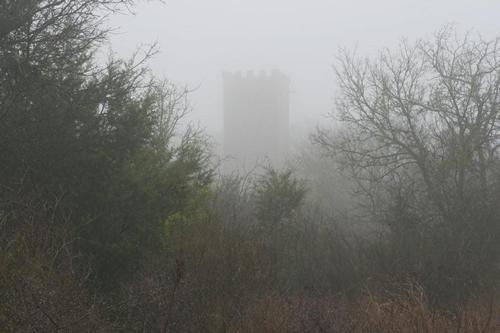|
The
tower has been the subject of conjecture for many years. Despite the
name, the structure was never a 19th century lookout. The rock structure
wasn’t constructed until sometime after 1923. The mountain was most
certainly a vantage point used by both Apaches and Comanches.
At 1,340 feet above sea level, it is the fourth highest elevation
in Bexar County.
|
T
he site once comprised 1,476 acres and was owned by one James Conn
in 1847. The property changed hands a number of times after that.
One notable owner was Mirabeau
Lamar, second president of the Republic
of Texas. Lamar’s deed referred to the property as “the hill known
as Comanche Lookout." Lamar’s heirs owned the property, but never
occupied the site.
In 1890, two German immigrant brothers (Gustav and Adolph Reeh) bought
the land and farmed it until Adolph died. Gustav sold part of the
property in 1923 to Colonel Edward H. Coppock , U.S. Army, (Retired).
Col. Coppock, an incurable romantic, started building a European-style
compound with the help of his two sons and a stonemason named Tarquino
Cavazos. Construction came to an end in 1948 when both Coppock and
Cavazos died. Foundations and (perhaps) a smaller tower and staircase
were bulldozed when a new owner purchased the site from Coppock’s
sons in 1968.
After numerous changes in ownership, the site was acquired by The
Resolution Trust Corporation in 1990. A preservation group called
Save Comanche Lookout was formed and the City of San
Antonio purchased the lookout to be a hiking trail and city park.
Source: San Antonio’s Parks and Recreation Department
official website. |
 |
A Walk Through
Comanche Lookout Park
Photos courtesy
Stephen
Michaels, February 2008 |
Photographer's
Note:
Comanche Lookout in San Antonio
I used to play here on this hill when I was a kid. Of course back
then, it was not a park or anything, and I used to actually climb
up on that tower! We had to fight back the bramble and thorns, but
it was always fun.
Now, it is a San Antonio park/hiking
trail complete with wheelchair access trails. The trails are full
of scenery itself as well as the views of the land from atop of the
hill. - Stephen
Michaels, February 2008 |
|
|
